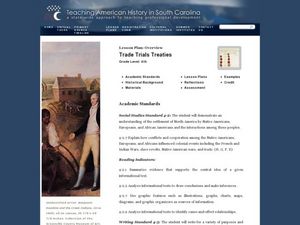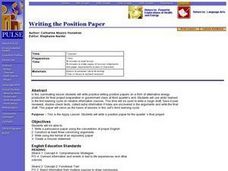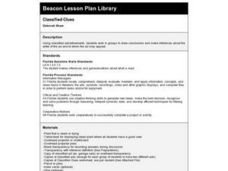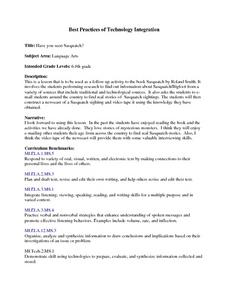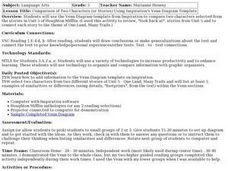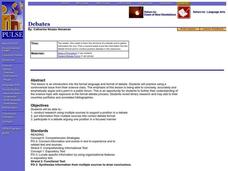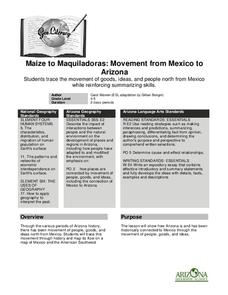Curated OER
Trade Trials Treaties
Fourth graders explore the trade relationships that existed in the late 1700's Colonial America. In this American history lesson, 4th graders examine English and Cherokee trade treaties by reviewing primary and secondary sources....
Curated OER
The Birth of a Rocky Mountain City and Railroad: Georgetown and the Loop Railroad
Students explore the evolution of a town. For this social studies lesson, students discuss why Georgetown and the Georgetown Loop Railroad were developed and discuss life as a prospector. Students write a letter explaining what life is...
Curated OER
How the West Was One: A Layered Book
Students create a layered book about the information they learn about the Western region of the United States. In this Western states lesson plan, students create a book about the land, economy, and culture.
Curated OER
Maize to Maquiladoras: Movement from Mexico to Arizona
Fourth graders label maps of Arizona and Mexico to show the people, goods, and ideas that have moved between the two places. In this Arizona and Mexico lesson plan, 4th graders summarize the effects of the movement on Arizona life.
Curated OER
A River Through Time
Learners explore how construction of a dam on the Gila River affected the lifestyle of Pima Indians. In this social studies lesson, students locate the Gila River and the Coolidge Dam. Learners record dates on a timeline and discuss how...
Curated OER
Writing the Position Paper
Students write position papers on a form of alternative energy production. They use several class periods to develop and write their paper and them participate in an extensive peer review session.
Curated OER
Revolt in Boston
Eleventh graders study the American Revolution. In this American History lesson, 11th graders analyze primary sources. Students participate in a simulation on taxes.
Curated OER
Surrender at Yorktown
Eighth graders examine the start of the American Revolution. In this American History lesson, 8th graders analyze primary sources. Students prepare a narration of events leading up to the revolution.
Curated OER
Sampling Snoops
Students practice formulating a hypothesis and designing an experiment to test the hypothesis. They identify several sampling techniques they can use to test their hypotheses.
Curated OER
Classified Cues
Learners analyze classified advertisements to make inferences about who wrote the ad and who may find the ad appealing. They write their own classified ads based on what they have learned.
Curated OER
Original Line or Familiar Find?
Students examine a primary source document from 1684 that includes many of the same lines found in Romeo's speech to Juliet from Shakespeare's Romeo and Juliet. Students compare the texts and discuss authorship during the sixteenth and...
Curated OER
Identifying Clouds
Students work in groups to research and prepare a report on cloud types. They present their findings to the class and take a group quiz competing for points. Students go outside and determine which type of clouds are visible on that day.
Curated OER
Have You Seen Sasquatch?
Students create a newscast documenting sightings of SasquatchBigfoot. Working individually, students research information on Sasquatch using traditional and electronic sources, including e-mail. The class produces a newscast based on...
Curated OER
Comparison of Two Characters Using Venn Diagram
Fifth graders compare characters of stories using venn diagrams. The use of technology is integrated into the lesson to meet a standard and engage learners.
Curated OER
Islamic Art
Young scholars examine the various forms of Islamic Art. Using the art, they identify the basic elements and research its history and style of calligraphy. They create a piece of art based on information they collected and demonstrate...
Curated OER
Debates
Students conduct research using multiple sources to support a position in a debate. They put information from multiple sources into correct debate format. Students participate in a debate arguing one position in a focused manner.
Curated OER
Breakfast Cereal - How Nutritious Is Yours?
Students analyze the nutritional value of breakfast cereal in order to make an informed choice. They create a stem and leaf plot which analyzes the nutritional value of the cereal they eat on a regular basis. Students write a letter to...
Curated OER
The Best Vacation Ever
Young scholars research various vacation destinations and the costs of travel. In this vacation planning activity, students obtain information for various purposes, research sites, document their findings, learn about geographical...
Curated OER
Health Education: An Integrated Approach; Unintentional Injuries
Third graders identify methods for preventing common injuries. In this injury prevention lesson, 3rd graders first study cartoons of injuries occurring, then write down their thoughts on these images. Next, the teacher shares many...
Curated OER
Urban and Rural Communities
Students discuss similarities and differences of urban and rural communities. For this urban and rural communities lesson, students compare urban and rural communities using a Venn Diagram. Students examine maps of each type of...
Curated OER
Graphs
Eighth graders analyze graphs on a worksheet and in newspapers and magazines. In this graphs lesson plan, 8th graders also record their thoughts in a journal.
Curated OER
Nomadic and Sedentary Tribes in Kansas
Seventh graders compare and contrast sedentary and nomadic tribe life. In this Native American culture instructional activity, 7th graders research primary documents about the Osage and Kiowa tribes. Students create a series of...
Curated OER
Maize to Maquiladoras: Movement from Mexico to Arizona
Students label maps of Arizona and Mexico of the products that moved from one place to another. In this Arizona and Mexico lesson plan, students also summarize the effects of the movement on life in Arizona.
Curated OER
Historical Figures
Second graders identify a historical figure, his or her societal contributions and basic biography using a Kidspiration graphic organizer and library resources. They use the Internet to conduct an historical treasure hunt in groups.


